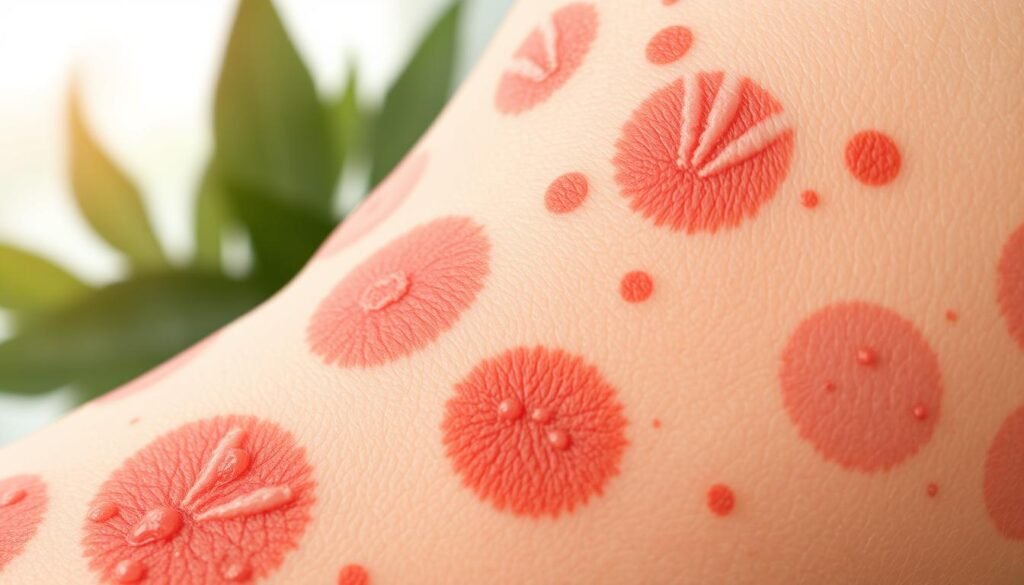Did you know that over 9.6 million kids in the U.S. have atopic dermatitis? It’s a common type of eczema. This condition leads to red, swollen, and very itchy skin. It can also greatly lower the quality of life for those dealing with it. Knowing how to handle severe eczema is key to improving life for those affected.
This article discusses the different forms, signs, triggers, and treatments for severe eczema. You will learn about home care tips, diet changes, and new therapies that offer relief. For an in-depth look at treating atopic dermatitis, check out Mayo Clinic’s website.
Key Takeaways
- Severe eczema affects millions and can cause asthma and allergies.
- Managing it well usually involves meds, skin care, and avoiding triggers.
- New eczema treatments include creams and cutting-edge biologics.
- Home care, like moisturizing often, can lessen flare-ups and reliance on meds.
- It’s crucial to understand how genetics and environment play a role in eczema.
- Recent advances in therapy are changing how patients manage eczema.
What is Severe Eczema?
Severe eczema is a tough skin condition that greatly affects many people. It’s important to know exactly what severe eczema definition means to treat it right. This disorder has many types. Each one has its own signs and symptoms. People with severe cases have a hard time. They need special care.
Defining Eczema and Its Types
Eczema is known for making skin inflamed, red, itchy, and dry. Atopic dermatitis is the most common kind of eczema. It’s often found in people who have allergies, asthma, or hay fever. Knowing all the types helps manage and prevent them better. Here are some common types:
| Type of Eczema | Characteristics |
|---|---|
| Atopic Dermatitis | Chronic condition often associated with allergies, characterized by dry and itchy skin. |
| Contact Dermatitis | Caused by irritants or allergens, leading to localized skin irritation. |
| Dyshidrotic Eczema | Manifests as small blisters on the hands and feet, typically triggered by stress or humidity. |
| Nummular Eczema | Presents as round, coin-shaped spots on the skin, often confused with fungal infections. |
| Seborrheic Dermatitis | Commonly affects the scalp, leading to flaky, greasy patches that can be itchy. |
Understanding Atopic Dermatitis
Atopic dermatitis is a long-lasting skin problem that’s tough to handle. It makes skin very itchy, dry, and prone to rashes. These rashes can be triggered by things like dust or pollen. They often show up on elbows, knees, and the faces of young kids. It starts in childhood and varies in how severe it can be.
People with serious cases face a lot of discomfort, and might even get infections. Treatments often include special creams and steroids. Some people might need newer treatments like biologics. It’s crucial to talk about allergic dermatitis to control symptoms well.
Recognizing Symptoms of Severe Eczema
It’s important to know the signs of eczema for successful treatment. Each person may show symptoms differently. This makes knowing early signs key to lessen eczema’s impact. It’s also important to tell eczema apart from other skin issues.
Common Signs and Symptoms
Severe eczema shows up in many ways, including:
- Red, inflamed patches of skin that might get crusty or scaly.
- Pruritus or serious itching, leading to more skin damage from scratching.
- Dry and cracked skin that looks thicker over time.
- Oozing or weeping blisters during bad episodes.
- Dark patches or skin color changes from constant irritation.
Eczema symptoms change over time. Some have flare-ups often, while others have constant symptoms. Knowing these signs helps with getting the right treatment early.
Differentiating from Other Skin Conditions
Telling severe eczema apart from other skin issues is key because symptoms can look similar. Issues like psoriasis, seborrheic dermatitis, and allergic dermatitis show similar symptoms. Here are some points to consider:
| Condition | Common Symptoms | Key Differences |
|---|---|---|
| Severe Eczema | Itchy, inflamed skin, oozing blisters, thickened patches | More common in younger people; often with allergies |
| Psoriasis | Red patches with silvery scales | Less itchy; usually appears evenly on both sides |
| Contact Dermatitis | Localized rash, redness, blistering | Caused by allergens or irritants; known exposure history |
Seeing a doctor is crucial for a correct diagnosis and to rule out other conditions. Recognizing the differences allows for better treatment, leading to improved lives for those suffering.

Triggers and Causes of Severe Eczema
Knowing what leads to severe eczema can help keep it under control. Eczema is influenced by both the surroundings and genes. It is crucial to spot these factors for better management.
Identifying Environmental Triggers
Things around us play a big role in causing eczema. Some well-known triggers are:
- Allergens such as dust mites, pollen, and mold.
- Irritants in certain soaps, detergents, and perfumes.
- Weather conditions, like extreme heat or cold and humidity.
Some jobs expose people more to these irritants, causing contact dermatitis. Stress also makes eczema worse. It makes the skin more prone to flare-ups.
The Role of Genetics and Family History
Genes play a big part in eczema. If eczema, allergies, or asthma run in your family, your risk goes up. Some gene changes make the skin weaker against eczema.
Kids with family history of eczema show it more often, especially with certain foods. Knowing these gene links helps in preventing eczema in high-risk babies.
Treatment Options for Severe Eczema
Treating severe eczema can feel overwhelming. There are many options out there to help patients. Starting with topical corticosteroids is common. They target inflammation and itchiness. It’s important to understand all treatments to manage eczema well.
Topical Corticosteroids
Topical corticosteroids are a key first step in treating severe eczema. They come in strong and very strong forms. Though effective at reducing inflammation, they can have side effects. These include headaches, acne, and in rare cases, more serious issues like seizures. It’s crucial to follow your healthcare provider’s guidance to use these safely.
Immunomodulators and Their Benefits
If corticosteroids don’t work, immunomodulators like tacrolimus (Protopic) and pimecrolimus (Elidel) might be next. These are good for treating sensitive areas. Side effects can happen, such as skin irritation and infections. Oral options like azathioprine also exist but carry risks like infection and kidney issues. Newer treatments like Dupilumab (Dupixent) offer hope with fewer side effects.
Alternative Treatments and Therapies
Many seek alternative therapies for severe eczema relief. Wet wrapping is one method that keeps skin moist. Phototherapy uses UVB and UVA light to ease symptoms. Also, simple steps like regular moisturizing and wearing soft clothes are key.

- Bleach baths can help moisturize and fight infection, though their effectiveness is debated.
- Other natural remedies include sunflower and coconut oils, and supplements like vitamin D and fish oil, though research is limited.
- Barrier repair moisturizers are advised for repairing skin and managing symptoms.
| Treatment Type | Form | Purpose | Side Effects |
|---|---|---|---|
| Topical Corticosteroids | Creams, Ointments | Reduce inflammation | Headaches, acne, seizures |
| Immunomodulators | Topical, Oral | Manage symptoms | Skin irritation, infection risk |
| Biologics | Injectables | Severe eczema treatment | Conjunctivitis, respiratory infections |
| Alternative Therapies | Various | Symptom management | Limited evidence for effectiveness |
Effective Eczema Therapy at Home
Effective home management of eczema blends moisturizing routines with self-care. A committed routine greatly lowers eczema’s effects on daily life.
Moisturizing Routines
A good moisturizing routine is key for eczema sufferers. Moisturizers should be applied right after a bath. This helps lock in moisture, battling the dryness eczema brings.
Products like petroleum jelly or sunflower seed oil soothe and protect the skin. Using them regularly helps stop itching and irritation.
Colloidal oatmeal baths or lotions also provide relief through their anti-inflammatory qualities. For additional home remedies, check this resource.
Daily Self-Care Practices
Daily self-care for eczema reduces triggers and supports skin health. Here are tips:
- Opt for mild cleansers instead of harsh soaps.
- Short, cool showers are better than long, hot ones.
- Wear soft clothing made of cotton or bamboo.
- Use humidifiers to keep indoor air moist.
- Manage stress through exercise or mindfulness.
Diet changes can also help manage eczema. Eating anti-inflammatory foods might lead to healthier skin. Learn more about useful diets in this article.

Dietary Interventions for Eczema Management
Changing your diet can really help manage eczema well. Some foods might help ease the symptoms, while others could make them worse. It’s important to focus on eating the right foods and watch out for allergies.
Foods to Include and Avoid
Adding anti-inflammatory foods to your diet is great for people with eczema. Here’s a list of foods to eat and those to avoid:
- Include:
- Vegetables
- Whole grains
- Legumes
- Fish rich in omega-3 fatty acids, like salmon
- Olive oil
- Avoid:
- Dairy products
- Whole grains and refined sugars
- Red meat
- Packaged and processed foods
Drinking lots of water, about eight 8-ounce glasses a day, can help too. Experts suggest trying diets like the Mediterranean or Ayurvedic. They focus on whole foods and anti-inflammatory spices.
The Impact of Allergies on Eczema
Food allergies can trouble some people with eczema. About 30% of eczema-affected kids have food allergies. Though cutting out certain foods might help, be careful with long-term elimination diets. They could lead to more allergies and miss out on important nutrients.
Probiotics and an anti-inflammatory diet could support you, but their proven impact is still uncertain. Everyone’s experience is different, so it’s crucial to find what works best for you.
Exploring Advanced Treatments for Severe Eczema
Severe eczema is becoming more common. There’s a growing need for advanced eczema treatments. Biologics are a new approach that targets the root cause of this condition. These treatments offer hope to those who don’t find relief in traditional methods.
Biologics: A New Frontier in Treatment
New biologic medications like Dupilumab (Dupixent) and Tralokinumab (Adbry) mark a big step forward. Dupilumab works by blocking certain immune proteins, helping both adults and children over six months. Many users report a better quality of life, showing biologics can change how we manage severe eczema.
Tralokinumab also targets specific immune responses, and it’s effective for adults. These biologics generally cause mild side effects, like conjunctivitis. Patients need ongoing monitoring and personalized treatment plans to get the best results.
Emerging Therapies and Medication
New treatments also include oral medications like upadacitinib (Rinvoq) and abrocitinib (Cibinqo). They work on more parts of the immune system but may have more side effects than biologics. When choosing a treatment, it’s vital to consider the eczema’s severity, where it’s located, and the patient’s history.
Research keeps bringing us new options for tackling eczema’s effects on the immune system. Places like Placer Dermatology & Skin Care Center offer tailor-made treatments. This means each person’s unique case of severe eczema can be managed more effectively.
Skin Barrier Repair Techniques
Managing severe eczema is closely linked with fixing and keeping up the skin barrier. This barrier shields us from irritants and helps keep moisture in. If the barrier is weak, skin can get dry and irritated. So, it’s key to know how to fix the skin barrier for anyone with eczema.
Importance of Barrier Maintenance
Keeping the skin barrier healthy is crucial for easing eczema symptoms. If the barrier is damaged, the skin can lose water. This leads to more dryness and irritation. Using the right methods can improve hydration and protection.
Look for hydrating creams that have ceramides, glycerin, and hyaluronic acid. Using these regularly can calm dry skin and bring back its balance.
Products and Ingredients to Look For
Choosing eczema care products means focusing on certain helpful ingredients. Below are some key ingredients and their benefits:
| Ingredient | Function | Example Products |
|---|---|---|
| Ceramides | Help restore the skin barrier and protect against moisture loss. | CeraVe Moisturizing Cream, Eucerin Advanced Repair Cream |
| Glycerin | Acts as a humectant, attracting moisture to the skin. | The Ordinary Hyaluronic Acid 2% + B5, Neutrogena Hydro Boost Gel Cream |
| Hyaluronic Acid | Provides intense hydration and helps maintain skin elasticity. | La Roche-Posay Hydraphase Intense, Vichy Aqualia Thermal Rich Cream |
| Vitamin C | Protects the skin barrier from damage caused by free radicals. | SkinCeuticals C E Ferulic, TruSkin Vitamin C Serum |
Adding these hydrating products to your daily skincare can really help in fixing the skin barrier. This makes life better for those with severe eczema. Talking to a dermatologist can offer personalized advice. This ensures the eczema is managed well.
Conclusion
Severe eczema is tough to handle and needs a careful strategy. It’s vital to know the condition well, spot different triggers, and explore many treatment paths. This empowers people with many ways to ease eczema, customized for their specific needs.
Working closely with medical professionals is key. This ensures treatment plans are tailored and consider new therapies and research findings. Though managing eczema takes effort and changes, making informed choices can greatly improve life and skin health.
People with eczema face many hurdles. It’s important to understand how genetics and environment play a part. Being proactive and learning about their condition helps individuals face their eczema journey with hope and resilience. With this, managing eczema effectively becomes an achievable goal.